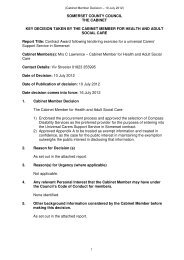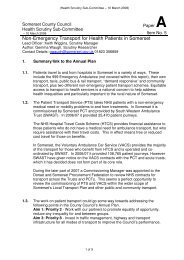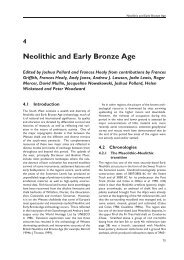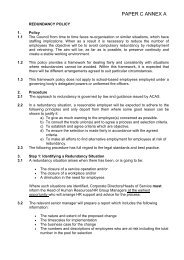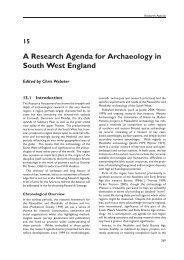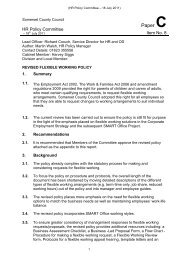Service Reviews â Outline Business Case - Somerset County Council
Service Reviews â Outline Business Case - Somerset County Council
Service Reviews â Outline Business Case - Somerset County Council
You also want an ePaper? Increase the reach of your titles
YUMPU automatically turns print PDFs into web optimized ePapers that Google loves.
(Cabinet – 2 May 2012)<br />
securing quality care may increase, In addition retention of the service does not fit<br />
with the <strong>Council</strong>’s aspirations to be a commissioning led organisation and a smaller<br />
more enabling authority.<br />
3.1.2 Benefits<br />
• Low or no short term impact on customers.<br />
• Retains skills, expertise, knowledge and existing service levels.<br />
• No additional or double funding of corporate overheads, including Southwest<br />
One<br />
• Retains direct provision within the public sector which many carers indicated a<br />
preference for as part of initial feedback events, citing recent criticism of<br />
independent sector services following the BBC Panorama investigation into<br />
Winterbourne View, and the failure of Southern Cross. However it should be<br />
noted that this preference was less prominent in feedback from people who use<br />
services.<br />
• Least likely to generate anxiety and resistance.<br />
• Maintaining the in-house provision avoids the risk of market failure, with its<br />
consequent dangers for vulnerable people and SCC's ability to meet its<br />
statutory responsibilities, as well as cost and reputational implications.<br />
• Allows SCC to retain the skills and experience necessary to tackle struggling<br />
providers in-house to ensure it meets its statutory obligations and gives it more<br />
control to respond to emergency situations<br />
3.1.3 Disbenefits and any potential mitigations<br />
• Unable to provide services funded by direct payments (which a number of<br />
people who used services expressed a preference for at initial feedback<br />
events). As more customers take advantage of DP’s there is significant risk to<br />
the <strong>County</strong> <strong>Council</strong> of them choosing alternative providers, therefore increasing<br />
unit costs. Even if this barrier was removed it is likely that the in-house service<br />
would find it difficult to develop new revenue streams as, once SCC corporate<br />
overheads are incorporated, hourly rates are unlikely to be competitive when<br />
compared to independent and not-for-profit providers<br />
• Retaining the LDPS in-house would require significant investment particularly<br />
relating to capital spend. Although projected future rates will bring the service<br />
more in-line with independent and not-for-profit providers this is expected to<br />
take 2 years, while a transfer to a different organisational model has the<br />
potential to release costs more quickly under the right conditions.<br />
• Inflexibilities in SCC corporate overheads costs means that the potential to<br />
maximise long term revenue savings will be more limited than options C and D.<br />
• There could be an “opportunity lost” with regard to introducing a step change<br />
through major service reconfiguration.<br />
• There would continue to be significant limitations in capital investment into the<br />
property portfolio due to on-going pubic sector austerity measures. Some<br />
properties are no longer “fit for purpose”, in terms of living (but not the care<br />
quality) environments. This increases the risk that customers who are directing<br />
their own care may choose independent sector providers over the in-house<br />
service, resulting in increased vacancies and therefore higher unit costs.<br />
A - 17





